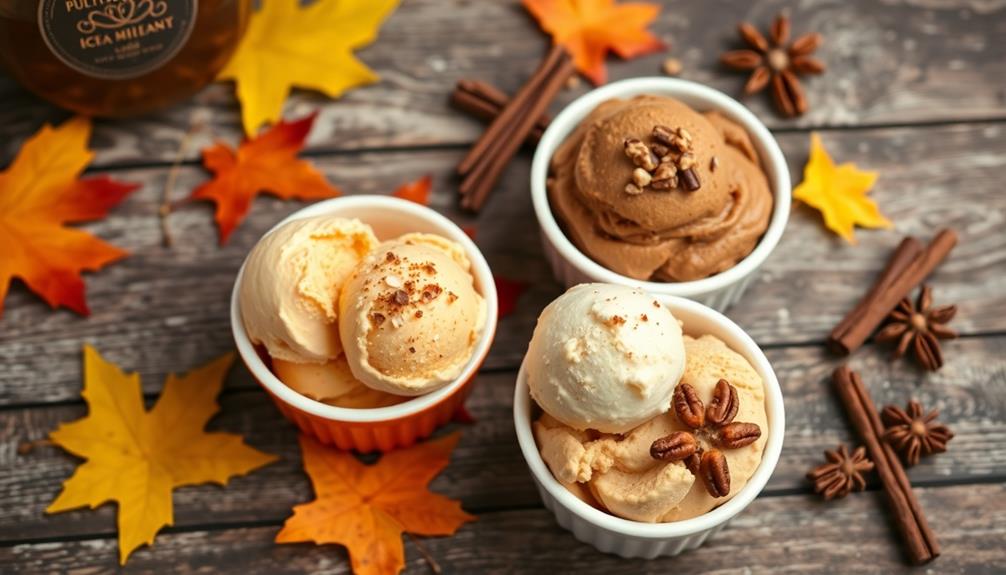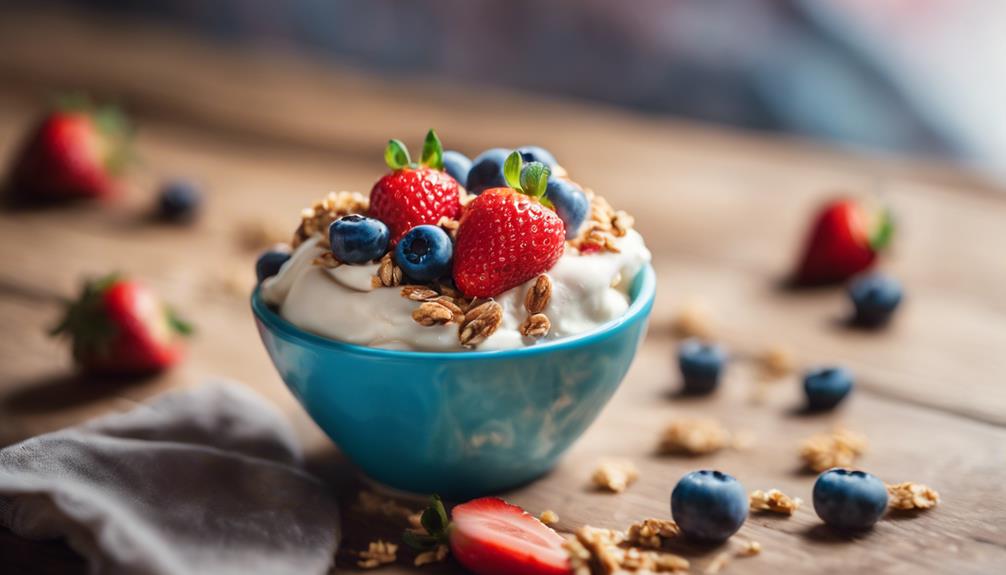You have a strong affinity for ice cream because of your taste receptors that can identify sweet flavors. Your brain’s central nervous system enhances your sweet cravings, and genetic evolution has programmed you to seek quick energy from sugary sources. The sugar in ice cream stimulates the release of dopamine in your brain and provides important nutrients. Enjoying it in moderation can bring both pleasure and nourishment. Furthermore, emotional attachment and comfort are key psychological factors that contribute to your cravings. The scientific explanation behind your love for ice cream is intriguing and sheds light on your uncontrollable urge for that sweet indulgence!
Key Takeaways
- Ice cream triggers pleasure responses in the brain through sweet taste receptors.
- Nutrients like protein, calcium, and vitamins in ice cream contribute to its appeal.
- Emotional attachment and positive memories drive cravings for ice cream.
- Dopamine release from sugar in ice cream creates feelings of comfort and happiness.
- Indulging in ice cream satisfies sweet cravings while providing psychological satisfaction.
Taste Receptors and Sweet Cravings
Taste receptors in your mouth and gut play an essential role in triggering your cravings for sweet foods. These receptors are specifically tuned to detect sweet flavors, sending signals to your brain that ignite a desire for sugary treats.
Four types of taste receptor cells work harmoniously to pick up on the presence of sugar, leading to the perception of sweetness in your mouth.
When you consume sugar or foods that rapidly increase blood sugar levels, these substances can have a profound impact on your hormones, intensifying your cravings for sweets.
Additionally, hyperpalatable foods, often rich in both sugar and fat, can stimulate the release of hormones that further fuel your desire for sweet indulgences.
Understanding how taste receptors function sheds light on why we're naturally drawn to sweet flavors and why we experience such strong cravings for sugary foods.
Central Nervous System and Cravings

Your central nervous system plays a pivotal role in influencing your cravings for sweet foods.
Taste receptor cells in your gut contribute to the brain's pleasure response when consuming sweet treats.
Evolution has wired humans to seek quick energy from sweet sources, impacting the way your brain forms associations with sugary foods.
Brain and Cravings Connection
The connection between your brain and cravings for sweet foods is deeply rooted in the central nervous system's influence on your dietary preferences. The brain's intricate network processes signals from the gut's taste receptor cells, signaling the pleasure associated with consuming sweet treats. This connection between the brain, pleasure, and cravings for sugary foods has evolutionary origins, as our ancestors sought quick energy sources for survival. As a result, our brains have developed a strong association between pleasure and sweet foods, leading to intensified cravings for treats like ice cream. Understanding this neurological link can help us make informed choices about our consumption habits and establish a healthier relationship with sugary foods.
| Sweet Cravings and the Brain | |
|---|---|
| Key Point 1 | The central nervous system influences dietary cravings. |
| Key Point 2 | Taste receptor cells in the gut signal pleasure to the brain. |
| Key Point 3 | Evolutionary factors contribute to the brain's preference for sweet foods. |
| Key Point 4 | Associations formed in the brain intensify cravings for sugary treats. |
Gut Receptors Influence
Gut receptors play a vital role in influencing your brain's perception of taste and cravings for sugary foods. Taste receptors located in your gut communicate with the central nervous system, providing information about the foods you consume. These receptors are essential in shaping your cravings by signaling the brain areas responsible for taste perception.
When you eat sweet foods, the brain associates this taste with pleasure, leading to an increased desire for sugary treats.
The genetic evolution of humans has also contributed to our preference for sweet foods. Over time, our ancestors developed a preference for quick energy sources like sugars, which are now ingrained in our biology. This evolutionary factor further enhances our cravings for sweet foods.
Additionally, taste receptors in the gut play a role in forming associations with specific foods, influencing your cravings. By understanding how these receptors impact your brain's perception of taste, you can gain insight into why you may crave certain sweet foods.
Evolutionary Factors Impact
Through genetic evolution, you have developed a preference for sweet foods as a means to seek quick energy sources, impacting your central nervous system and influencing cravings. The connection between the central nervous system and the digestive tract plays a pivotal role in shaping your desire for sugary treats. Taste receptors in your gut communicate with your brain, associating pleasure with consuming sweets. This link between genetics and cravings is deeply rooted in your evolutionary past, where seeking out sugar-rich foods was essential for survival.
Your genetic makeup has hardwired you to crave sweet foods due to their high energy content. This preference for sweetness has been honed over generations, enhancing your desire for sugary treats like ice cream. By understanding the evolutionary factors influencing your cravings, you can appreciate why indulging in a scoop of ice cream brings you such satisfaction.
Sugar's Impact on Health

Excessive consumption of sugar directly impacts your overall health and well-being, leading to various detrimental effects such as dental caries, metabolic syndrome, and obesity.
Added sugars, commonly found in processed foods, significantly contribute to these health issues. High blood sugar levels resulting from excessive sugar intake can increase the risk of developing metabolic syndrome, a cluster of conditions that raise the chances of heart disease, stroke, and type 2 diabetes.
Besides, the constant exposure to sugary foods can alter your taste perception, making you crave even more sugar-laden treats. Obesity, another consequence of overindulging in sugary foods, not only affects your physical appearance but also increases the likelihood of developing chronic diseases.
Thus, monitoring your sugar intake is essential for maintaining a healthy lifestyle and preventing the onset of these serious health conditions. Remember, moderation is key when it comes to enjoying sweet treats while prioritizing your well-being.
Mindful Consumption Habits

Developing mindful consumption habits can positively impact your relationship with sweet foods and overall eating behavior.
Here are three practical ways to incorporate mindful eating practices into your daily routine:
- Eat slowly and savor each bite: By taking your time to enjoy your food, you can become more aware of the flavors and textures, leading to a greater appreciation for the sweetness of treats like ice cream.
- Engage in meal planning and food preparation: Taking an active role in planning and preparing your meals allows you to control the amount of sugar in your diet, promoting healthier choices when it comes to consuming sweet foods.
- Chew your food thoroughly: Properly chewing your food not only aids in digestion but also encourages mindful eating by forcing you to slow down and savor the taste of what you're consuming. This can help you make more conscious decisions about your sweet treats.
Nutrition of Ice Cream

Let's talk about the nutrition of ice cream. Ice cream provides essential nutrients like protein, calcium, and vitamins A and D.
But it's important to be mindful of the sugar content. Understanding the impact of sugar in ice cream can help you make informed choices about your indulgences.
Nutritional Benefits of Ice Cream
Ice cream provides essential nutrients such as protein, calcium, vitamins A, and D, making it a surprisingly beneficial treat. Here are three ways ice cream offers nutritional benefits:
- Protein: Ice cream contains dairy, which is a good source of protein vital for muscle growth and repair.
- Calcium: The calcium in ice cream helps maintain strong bones and teeth, supporting overall bone health.
- Vitamins A and D: Ice cream contributes to your daily intake of vitamins A and D, important for vision, immune function, and bone health.
The combination of these nutrients impacts brain chemistry by influencing cravings and enjoyment.
The sugar in ice cream triggers the release of dopamine, a neurotransmitter associated with pleasure.
While indulging in ice cream can be a delightful experience, it's essential to consume it in moderation to prevent disruptions in blood sugar levels and potential health issues.
Balancing enjoyment with nutritional awareness can help you savor your favorite frozen treat responsibly.
Impact of Sugar
How does the sugar content in ice cream affect your overall nutrition intake and health?
Ice cream's sugar content plays a significant role in the delicious treat's impact on your body. When you indulge in ice cream, the sugar it contains triggers the release of dopamine in your brain, which is a neurotransmitter associated with pleasure and reward.
While ice cream offers vital nutrients like protein, calcium, and vitamins A and D, consuming excessive amounts of sugar from this dessert can lead to disruptions in your blood sugar levels.
It's crucial to be mindful of your sugar intake from ice cream to maintain a balanced diet and prevent potential health issues related to high sugar consumption. By understanding the impact of sugar in ice cream, you can better manage your cravings and make informed choices about when and how much of this sweet treat to enjoy.
Cravings and Indulgence
Indulging in ice cream satisfies more than just your sweet cravings; it also provides essential nutrients important for overall health. When you give in to your cravings and enjoy a scoop of ice cream, you're not just indulging in a tasty treat; you're also benefiting from the nutritional value it offers:
- Protein: Ice cream contains protein, which is essential for building and repairing tissues in your body, supporting muscle growth, and maintaining a healthy immune system.
- Calcium: Enjoying ice cream can contribute to your daily calcium intake, vital for strong bones and teeth, muscle function, and nerve transmission.
- Vitamins A and D: Ice cream is a source of vitamins A and D, important for maintaining healthy vision, skin, and immune function, as well as supporting calcium absorption and bone health.
Next time you savor a scoop of ice cream, remember that besides the pleasure it brings, you're also nourishing your body with valuable nutrients.
Psychological Factors in Cravings

Understanding the psychological factors at play is essential in deciphering the complex nature of cravings.
When it comes to ice cream, psychological factors such as emotional attachment and the concept of comfort food play a significant role in driving your desire for this sweet treat. Ice cream cravings are often linked to positive memories and experiences, triggering a sense of comfort and happiness.
It's not just about the taste; it's about the psychological satisfaction that indulging in ice cream provides.
Positive past experiences can strongly influence your cravings for ice cream, making it a go-to choice when seeking comfort or a mood boost. By recognizing and understanding these psychological factors, you can better manage and control your indulgences in ice cream.
Next time you find yourself longing for a scoop of your favorite flavor, remember that there's more to it than just a simple craving – it's a mix of emotions and memories that contribute to your love for ice cream.
Frequently Asked Questions
What Is the Science Behind Why We Love Ice Cream?
You love ice cream because it triggers dopamine and serotonin release in your brain. Emotional triggers and positive memories enhance the experience. The cold temperature stimulates your taste buds. Nutrients like protein and calcium add more than just sweetness.
Why Do Humans Like Ice Cream so Much?
You like ice cream so much because its blend of sugar, fat, and frozen deliciousness triggers irresistible cravings. The chemistry behind this treat's perfect mix of ingredients is engineered to appeal to your taste buds.
What Is the Psychology Behind Eating Ice Cream?
Indulging in ice cream taps into your emotions and memories, creating a strong desire for this sweet treat. The brain's pursuit of pleasure reinforces cravings, making it a go-to comfort food. Understanding this psychology helps manage indulgence.
Does Ice Cream Scientifically Make You Happy?
Oh, absolutely! Ice cream's like a happiness ninja, sneaking into your brain and releasing all those feel-good chemicals. Sugar and cold temps team up, triggering dopamine and serotonin for a joyous party!
Can the Science of Sweet Cravings Explain Why People Love Sugar-Free Ice Cream?
Looking for guiltfree sugarfree ice cream options? The science of sweet cravings suggests that our love for sugar can be satisfied without the guilt. Sugar-free ice cream provides a solution for those with a sweet tooth but are conscious about their sugar intake. Indulge in delicious flavors without the sugar.
Conclusion
So next time you find yourself reaching for that creamy, sweet scoop of ice cream, remember that it's not just your taste buds calling for a treat. Your brain, taste receptors, and even your emotions are all in on the action.
Indulge in moderation, savoring each bite like a cool breeze on a hot summer day.
Ice cream is more than just a dessert – it's a sweet symphony for your senses.









